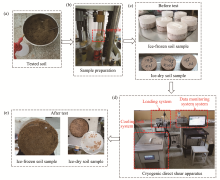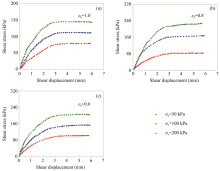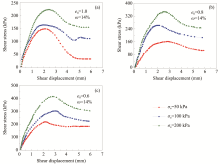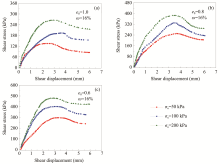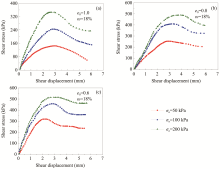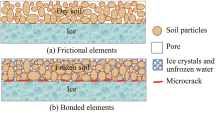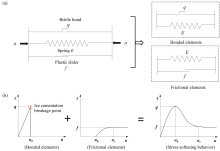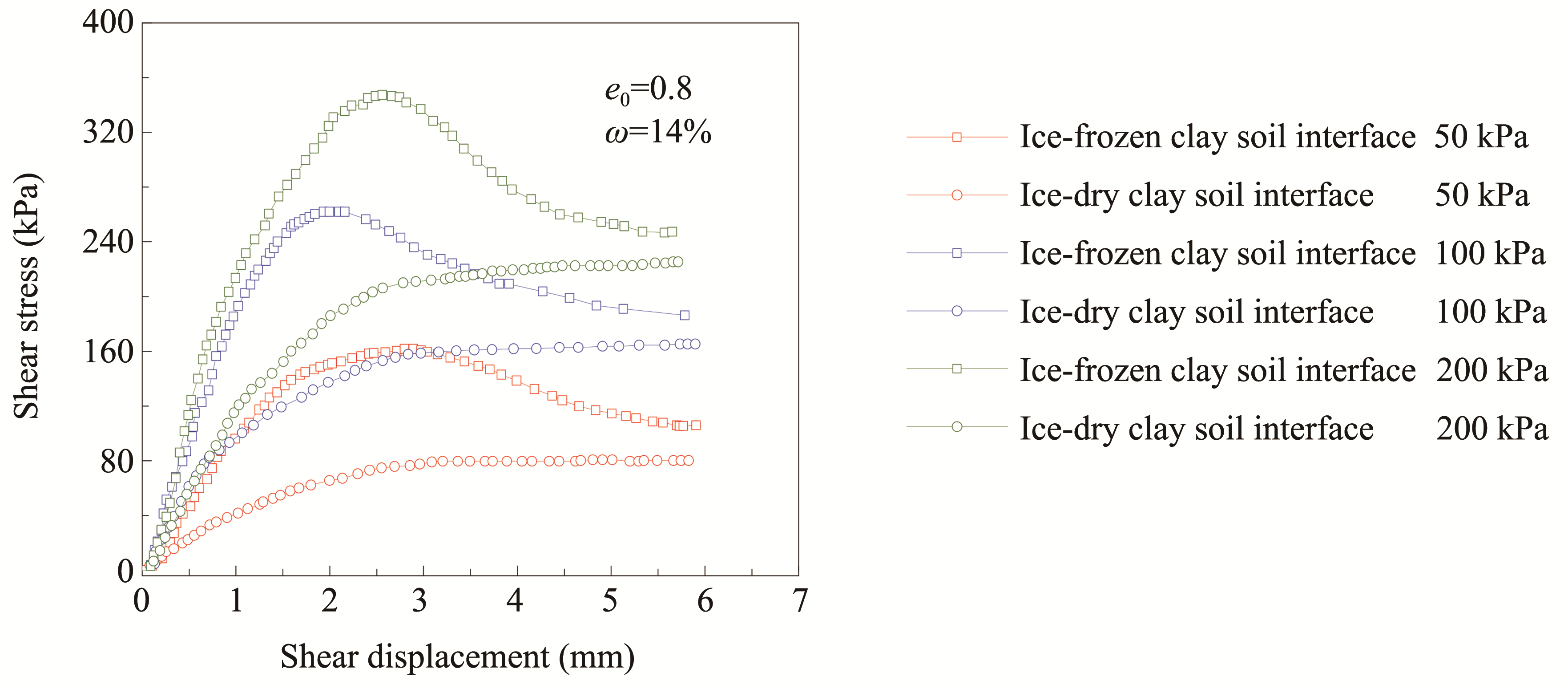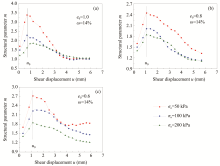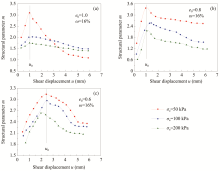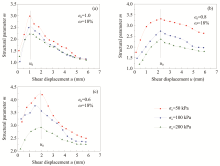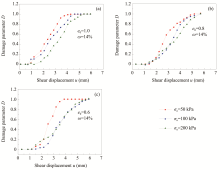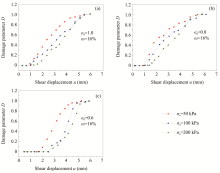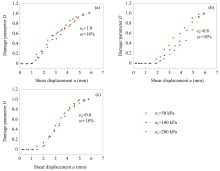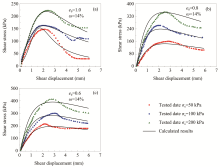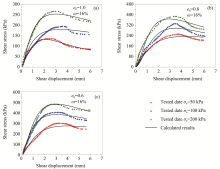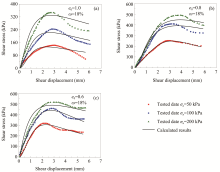Sciences in Cold and Arid Regions ›› 2021, Vol. 13 ›› Issue (2): 150–166.doi: 10.3724/SP.J.1226.2021.20050
• • 上一篇
A nonlinear interface structural damage model between ice crystal and frozen clay soil
Sheng Shi1,Feng Zhang1,2( ),KangWei Tang1,DeCheng Feng1(
),KangWei Tang1,DeCheng Feng1( ),XuFeng Lu1
),XuFeng Lu1
- 1.School of Transportation Science and Engineering, Harbin Institute of Technology, Heilongjiang, Harbin 150090, China
2.State Key Laboratory of Road Engineering Safety and Health in Cold and High-Altitude Regions, CCCC First Highway Consultants Co. , Ltd. , Xi'an 710075, China
|
Ali N, Mahzad EF, Hooshang K, et al., 2018. A new approach to modeling the behavior of frozen soils. Engineering Geology, 246: 82-90. DOI: https://doi.org/10.1016/j.enggeo. 2018.09.018.
doi: 10.1016/j.enggeo. 2018.09.018 |
|
|
Arenson LU, Springman SM, 2005. Mathematical descriptions for the behaviour of ice-rich frozen soils at temperatures close to 0 ℃. Canadian Geotechnical Journal, 42(2): 431-442. DOI: https://doi.org/10.1139/t04-109.
doi: 10.1139/t04-109 |
|
| ASTM, 1998. Standard test method for direct shear test of soils under consolidated drained conditions. ASTM Standard D3080-98. | |
| Bondarenko GI, Sadovskii AV, 1975. Strength and deformability of frozen soil in contact with rock. Soil Mechanics and Foundation Engineering, 12(3): 174-178. | |
|
Bray MT, French HM, Shur Y, 2006. Further cryostratigraphic observations in the CRREL Permafrost Tunnel, Fox, Alaska. Permafrost and Periglacial Processes, 17: 233-243. DOI: https://doi.org/10.1002/ppp.558.
doi: 10.1002/ppp.558 |
|
|
Bray MT, 2012. The influence of cryostructure on the creep behavior of ice-rich permafrost. Cold Regions Science and Technology, (79-80): 43-52. DOI: https://doi.org/10.1016/j.coldregions.2012.04.003.
doi: 10.1016/j.coldregions.2012.04.003 |
|
|
Chen SS, Zang SY, Sun L, 2020. Characteristics of permafrost degradation in Northeast China and its ecological effects: A review. Sciences in Cold and Arid Regions, 12(1): 1-11. DOI: https://doi.10.3724/SP.J.1226.2020.00001.
doi: https://doi.10.3724/SP.J.1226.2020.00001 |
|
| Cudmani R, 2006. An elastic-viscoplastic model for frozen soils. Numerical Modelling of Construction Processes in Geotechnical Engineering for Urban Environment. Taylor & Francis Group, London, pp. 177-183. | |
|
Di Donna A, Ferrari A, Laloui L, 2015. Experimental investigations of the soil-concrete interface: physical mechanisms, cyclic mobilization, and behavior at different temperatures. Canadian Geotechnical Journal, 53(4): 659-672. DOI: https://doi.10.1139/cgj-2015-0294.
doi: https://doi.10.1139/cgj-2015-0294 |
|
|
French H, Shur Y, 2010. The principles of cryostratigraphy. Earth-Science Reviews, 101: 190-206. DOI: https://doi.org/10.1016/j.earscirev.2010.04.002.
doi: 10.1016/j.earscirev.2010.04.002 |
|
|
Lai YM, Li SY, Qi JL, 2008. Strength distributions of warm frozen clay and its stochastic damage constitutive model. Cold Regions Science and Technology, 53(2): 200-215. DOI: https://doi.org/10.1016/j.coldregions.2007.11.001.
doi: 10.1016/j.coldregions.2007.11.001 |
|
|
Lai YM, Jin L, Chang XX, 2009. Yield criterion and elasto-plastic damage constitutive model for frozen sandy soil. International Journal of Plasticity, 25: 1177-1205. DOI: https://doi.org/10.1016/j.ijplas.2008.06.010.
doi: 10.1016/j.ijplas.2008.06.010 |
|
|
Lai YM, Li JB, Li QZ, 2012. Study on damage statistical constitutive model and stochastic simulation for warm ice-rich frozen silt. Cold Regions Science and Technology, 71: 102-110. DOI: https://doi.org/10.1016/j.coldregions.2011. 11.001.
doi: 10.1016/j.coldregions.2011. 11.001 |
|
|
Lai Y, Xu X, Yu W, 2014. An experimental investigation of the mechanical behavior and a hyperplastic constitutive model of frozen loess. International Journal of Engineering Science, 84: 29-53. DOI: https://doi.org/10.1016/j.ijengsci. 2014.06.011.
doi: 10.1016/j.ijengsci. 2014.06.011 |
|
|
Lai Y, Liao M, Hu K, 2016. A constitutive model of frozen saline sandy soil based on energy dissipation theory. International Journal of Plasticity, 78: 84-113. DOI: https://doi.org/10. 1016/j.ijplas.2015.10.008.
doi: 10. 1016/j.ijplas.2015.10.008 |
|
|
Ladanyi B, 1995. Frozen soil-structure interfaces. Studies in Applied Mechanics, 42(6): 3-33. DOI: https://doi.org/10. 1016/S0922-5382(06)80004-8.
doi: 10. 1016/S0922-5382(06)80004-8 |
|
|
Li SY, Lai YM, Zhang SJ, 2009. An improved statistical damage constitutive model for warm frozen clay based on Mohr-coulomb criterion. Cold Regions Science and Technology, 57(2): 154-159. DOI: https://doi.org/10.1016/j.coldregions.2009.02.010.
doi: 10.1016/j.coldregions.2009.02.010 |
|
|
Li SY, Niu FJ, Lai YM, et al., 2017. Optimal design of thermal insulation layer of a tunnel in permafrost regions based on coupled heat-water simulation. Applied Thermal Engineering, 110: 1264-1273. DOI: https://doi.org/10.1016/j.applthermaleng.2016.09.033.
doi: 10.1016/j.applthermaleng.2016.09.033 |
|
|
Liu EL, Lai YM, Liao MK, et al., 2016. Fatigue and damage properties of frozen silty sand samples subjected to cyclic triaxial loading. Canadian Geotechnical Journal, 53: 1939-1951. DOI: https://doi.org/10.1139/cgj-2016-0152.
doi: 10.1139/cgj-2016-0152 |
|
|
Liu J, Lv P, Cui Y, 2014. Experimental study on direct shear behavior of frozen soil-concrete interface. Cold Regions Science and Technology, (104-105): 1-6. DOI: https://doi.org/10. 1016/j.coldregions.2014.04.007.
doi: 10. 1016/j.coldregions.2014.04.007 |
|
|
Ma W, Cheng GD, Wu QB, et al., 2005. Application on idea of dynamic design in Qinghai-Tibet railway construction. Cold Regions Science and Technology, 41: 165-173. DOI: https://doi.org/10.1016/j.coldregions.2004.09.002.
doi: 10.1016/j.coldregions.2004.09.002 |
|
|
Murphy KD, McCartney JS, 2014. Thermal borehole shear device. Geotechnical Testing Journal, 37(6): 20140009. DOI: https://doi.10.1520/GTJ20140009.
doi: https://doi.10.1520/GTJ20140009 |
|
|
Rotta LAF, Frigo B, Chiaia B, 2017. A non-linear constitutive model for describing the mechanical behavior of frozen ground and permafrost. Cold Regions Science and Technology, 133: 63-69. DOI: https://doi.org/10.1016/j.coldregions.2016.10.010.
doi: 10.1016/j.coldregions.2016.10.010 |
|
| Sayles FH, 1973. Triaxial and creep tests on frozen Ottawa sand. Proceeding of 2nd International Permafrost Conference. Washington, D.C: National Academy of Sciences, pp. 384-391. | |
| Shur YL, Jorgenson MT, 1998. Cryostructure development on the floodplains of Colville River Delta, Northern Alaska. Permafrost. Proceedings of 7th International Conference, Yellowknife, Canada, pp. 993-999. | |
|
Wang S, Qi J, Yin Z, 2014. A simple rheological element based creep model for frozen soils. Cold Regions Science and Technology, (106-107): 47-54. DOI: https://doi.org/10. 1016/j.coldregions.2014.06.007.
doi: 10. 1016/j.coldregions.2014.06.007 |
|
|
Yamamoto Y, Springman SM, 2014. Axial compression stress path tests on artificial frozen soil samples in a triaxial device at temperatures just below 0 ℃. Canadian Geotechnical Journal, 51(10): 1178-1195. DOI: https://doi.10.1139/cgj-2013-0257.
doi: https://doi.10.1139/cgj-2013-0257 |
|
|
Yazdani S, Helwany S, Olgun G, 2019. Influence of temperature on soil-pile interface shear strength. Geomechanics for Energy and the Environment, 18: 69-78. DOI: https://doi.org/10.1016/j.gete.2018.08.001.
doi: 10.1016/j.gete.2018.08.001 |
|
|
Yang Y, Lai Y, Chang X, 2010. Experimental and theoretical studies on the creep behavior of warm ice-rich frozen sand. Cold Regions Science and Technology, 63(1): 61-67. DOI: https://doi.org/10.1016/j.coldregions.2010.04.011.
doi: 10.1016/j.coldregions.2010.04.011 |
|
|
Yang Y, Gao F, Cheng H, 2014. Researches on the constitutive models of artificial frozen silt in underground engineering. Advances in Materials Science and Engineering, 17: 1-8. DOI: https://doi.10.1155/2014/902164.
doi: https://doi.10.1155/2014/902164 |
|
|
Zhang D, Liu EL, 2019. Binary-medium-based constitutive model of frozen soils subjected to triaxial loading. Results in Physics, 12: 1999-2008. DOI: https://doi.org/10.1016/j.rinp.2019.02.029.
doi: 10.1016/j.rinp.2019.02.029 |
| No related articles found! |
|
||

